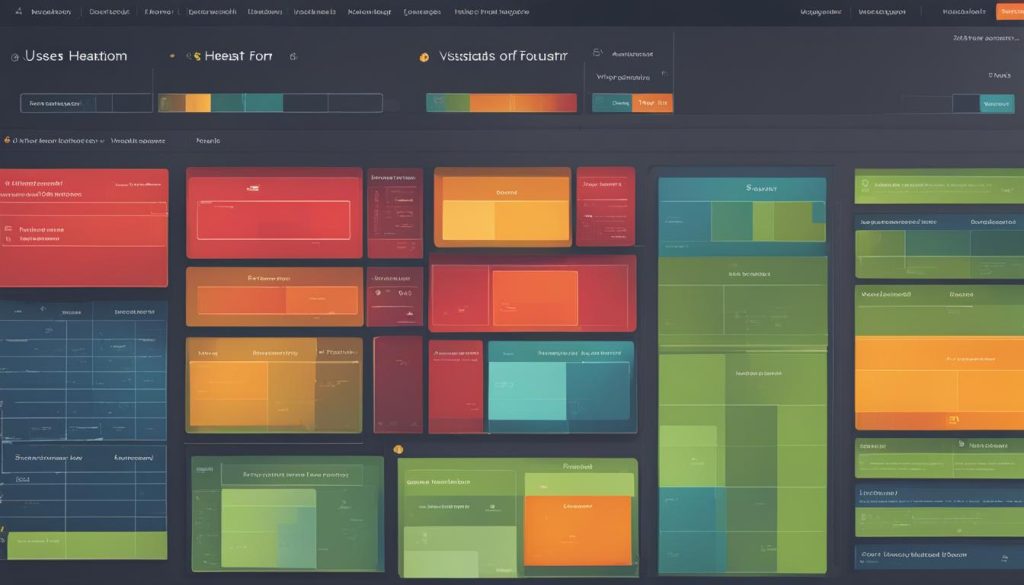In today’s data-driven landscape, your ability to optimise conversion rates hinges on the fine-tuning of every digital touchpoint. Understanding the tools and methodologies such as A/B testing, form refinement, and conversion optimisation can significantly alter your business’s trajectory. By sharpening your call-to-action (CTA) strategies and advancing user experience enhancements, you can transform how potential clients interact with your demo pages, pushing the boundaries of possible conversion outcomes. At Grew Studio, under the guidance of CEO Adam Oliver Kollar, we uphold the ethos that meticulous attention to detail in form optimisation can drastically elevate B2B SaaS conversions.
Whether it’s the strategic relocation of your CTA or the invocation of action through creative button texts like “See Us in Action” instead of the mundane “Submit,” every change is a step towards a more user-centric design. Achieve an enriched visitor experience with continuous iterative enhancements, and elevate your website’s effectiveness. To support your endeavours, Grew Studio extends an invitation for a complimentary 30-minute strategic business consultation, focusing on enhancing your site and marketing strategies.
Key Takeaways
- Employ A/B testing to discern what influences visitor decisions on your demo pages.
- Utilise creative CTA verbiage to foster engagement and click-through.
- Form refinement is a critical aspect of conversion optimisation.
- Detailed adjustments in content and design can lead to profound improvements in user experience.
- Take advantage of free strategic consultations to gain insights into enhancing your website and marketing performance.
Understanding the Impact of Form Refinement on Conversion Rates
As your digital storefront, the website design commands immediate influence on user perception and interaction. Within this virtual space, refining the structure and aesthetics of your forms can significantly alter the user’s experience and, subsequently, your conversion rates. Empirical evidence attests to the integral role that UX/UI design principles play in enhancing form usability and smoothing the path through the conversion funnel.

Whether through minimalist aesthetics or intuitive steps, each adjustment to your form can result in a surge of user engagement, thereby advancing the effectiveness of your marketing strategy. To realise the potential of these modifications, it is vital to deploy engagement strategies that align with the inclinations and behaviours of your target audience.
Imagine the gains to be secured by employing A/B testing; a manoeuvre allowing you to pinpoint, with precision, the variant of your Call-To-Action that maximises user response. This process of iterative refinement is not merely beneficial but essential for a SaaS demo page poised to become a fulcrum of conversion-driving force.
Let us delve into the anatomy of a form that capitalises on the principles of form usability:
- An intuitive layout which harmoniously blends with the overall site
- A clear and compelling CTA that beckons action
- Minimal steps to completion to prevent user fatigue
- Responsive design for seamless functionality across devices
Thus, an unwavering commitment to data-driven insights and an ethos of continuous learning propels your SaaS demo page to unprecedented heights in conversion optimisation. By shining the spotlight on user centricity, your form’s evolution becomes synonymous with a flourishing online presence.
Decoding User Behaviour to Guide Form Optimisation
In the quest to refine your online forms, understanding the intricacies of user behaviour is imperative. By paying close attention to visitor interactions with your forms, you can uncover vital patterns and tendencies that inform strategic enhancements.
The Role of A/B Testing in Understanding Visitor Interaction
A/B testing serves as a pioneering method for capturing invaluable user feedback, granting you the insights needed to tailor form design for optimal user engagement. This comparative approach tests two variations of your form to determine which proves more effective, thereby guiding your form design enhancements with empirical data.

Employing Heatmaps to Identify User Focus Areas
One of the most insightful tools in the conversion tracking arsenal, heatmap analysis illuminates the hotspots of user activity on your forms. By visually representing where users click, move, and scroll, heatmaps offer a vivid depiction of visitor behaviour. Consequently, these insights facilitate a deep dive into session analysis, revealing how to streamline your form design to align with user patterns and preferences.
Both visitor behaviour analysis and heatmap interpretation are key to sculpting a user journey that not only meets expectations but enhances them. By meticulously analysing these factors, every modification and tweak becomes a targeted stride towards boosting form efficiency and conversion rates.
Strategically Placing Call-To-Action for Maximal Engagement
Effective engagement strategies rely on placing your Call-To-Action (CTA) in positions of your website that command attention and provoke action. This process, called CTA placement optimization, is pivotal in ensuring that visitors interact with your site as desired, potentially leading to a significant conversion rate uplift.
Incorporating button text creativity into your CTA can make a profound difference. The language and tone you employ should resonate with your target audience, encapsulating a user-centric design. For instance, swapping a standard “Submit” with “Unlock Your Full Potential” could transform user engagement. It’s about understanding the language that stirs emotion and prompts your users to click through.
Remember, the power of persuasion lies not just in what you say but also in how you present it. Optimize every CTA to make each user feel as though they’re embarking on an exclusive journey.
Utilise A/B testing to compare different CTA placements. You might start with your CTA above the fold and test it against a variation where the CTA is nestled within engaging content or at the end of a compelling narrative. While testing, consider elements such as:
- Button size and colour
- Visibility of the CTA on various devices
- Button text and typography
- Page elements surrounding the CTA
Through rigorous experimentation and a willingness to embrace data-driven insights, your site can achieve an enviable state of user-centric harmony where each CTA placement feels intuitive and yields improved engagement.
To illustrate, consider the following comparison between two CTA placement strategies:
| CTA Placement | User Interaction | Conversion Impact |
|---|---|---|
| Above the Fold | Immediate visibility, higher interaction | Potential for quick but possibly lower quality conversions |
| Within Content | Engaged users more likely to convert | Higher quality conversions from educated audience |
Ultimately, the “best” placement will vary based on your specific audience and the purpose of your site. Monitor user behaviour, gather feedback and continuously refine your approach. The key is to align engagement strategies with a user-centric design philosophy to maximise both the user’s experience and your conversion rates.

Operate with the intent to not just attract eyes to your CTA but to convince minds that the action is worth their time. The right combination of placement, language, and design can transform passive browsers into active participants in your site’s experience and, ultimately, your business’s success.
The Psychology Behind Effective Form Design
Delving into the psychology of effective form design is not just about aesthetics; it’s about leveraging psychological triggers to enhance user engagement and visitor retention. Your forms are not merely a means to an end; they are a crucial touchpoint in the customer journey understanding that can make or break the marketing strategy you’ve painstakingly developed.
Imagine a form that not only captures information but also captivates the user by tapping into the universal fear of missing out (FOMO). This compelling approach is scientifically proven to increase the likelihood of completion.
- **Social Proof**: Including testimonials or user count can reassure visitors of your service’s reliability.
- **Urgency**: Setting a time limit for an offer can encourage quicker decision-making and form submission.
- **Simplicity**: A clean, uncluttered form design reduces cognitive load, making the completion process feel effortless.
The above elements are more than just features; they are cohesive parts of a narrative where each interaction is designed to trigger a response aligned with the desired outcome.

Take urgency, for instance; by infusing your form design with time-sensitive language or visual cues that indicate an offer’s limitation, you can spark the intrinsic human tendency to take immediate action to avoid missing out. This is a powerful motivator and when used wisely, can significantly uplift conversion rates.
But remember, the key is subtlety and relevance. An overuse of psychological triggers can be perceived as manipulative and may actually harm your brand perception and thus, your conversion rates.
Understanding the fine line between influence and manipulation is paramount when embedding psychological aspects into your forms. When executed effectively, you’re not simply designing a form; you’re creating an experience that resonates and converts.
By considering these psychological factors and how they interact with one another, your form design moves beyond functionality to become a seamless and integral part of the user’s journey—a journey that, ideally, concludes with a form submission, a new lead, or a converted customer.
Streamlining Forms to Enhance User Experience
In today’s digital landscape, the efficiency and usability of forms on your website can have a significant impact on user experience and, ultimately, conversion rates. By focusing on streamlined form design, you can make the process of information gathering as smooth and painless as possible for users, thereby improving retention and lead quality.
Balancing Simplicity with Information Gathering
Striking the right balance between simplicity in form design and the need to gather vital information can be challenging. Yet, it is essential for enhancing user experience improvement. Your objective should be to create a form that asks for the necessary information in as few steps as possible, without overwhelming your users. This approach leads to increased information gathering efficiency without sacrificing user engagement.

Optimising Field Arrangement and Error Handling for User Retention
The arrangement of fields within a form can make a difference in how users perceive the task of form-filling. An intuitive field arrangement guides the user logically through the process, enhancing form usability. Moreover, intelligent error handling that offers clear, constructive feedback can prevent users from abandoning the form. It ensures that any input mistakes are corrected promptly, making the experience less frustrating and more likely to retain the user.
Through improving these aspects, you fortify your forms against the risks of high drop-off rates, thereby securing a robust platform for user experience improvement and lead capture. Remember, a streamlined form is not just about aesthetics; it’s about creating a functional, user-friendly interface that supports your site’s goals and serves your audience’s needs.
Customising the Conversion Pathway Through Personalised Touchpoints
The artistry of enhancing your user’s journey lies in the subtle yet profound ability to create personalised form experiences. With today’s advanced visitor personalisation techniques, you can tailor each interaction along the conversion pathway to reflect the distinct preferences and needs of your user segments.
Segmenting Visitors for Tailored Form Interactions
Imagine a world where every form you encounter feels like it’s been crafted just for you. That’s the power of user segmentation and form design customisation. By categorising users based on specific criteria such as behaviour, demographic, or transactional data, you pave the way for tailored interactions that strike a chord with each individual.
- Demographic Information: Customise forms according to age, location, and job title.
- Behavioural Data: Dynamically alter form fields based on user’s past interactions with your site.
- Transactional History: Prefill forms based on previous purchases or enquiries to streamline the process.
Injecting Personalisation to Foster Connection with Users
It’s not just about recognition, it’s about relevance. Injecting a degree of personalisation into your forms goes beyond addressing your users by name. It encapsulates providing recommendations and options that resonate with their history and preferences. Effective personalisation turns a mundane form filling process into an experience of meaningful interaction and engagement.
“Personalised experiences are not a luxury but a proven method to increase conversion rates and foster user loyalty.”
In the endeavour to personalise the user experience, it is paramount to harness the potential of form design customisation meticulously. The intricacies of crafting an interactive environment that feels both unique and intuitive to the user are what ultimately culminate in higher engagement and conversion success.
Improving Form Design and Usability by Prioritising Visitor Segmentation
When you prioritise visitor segmentation, you’re taking a significant step towards enhancing both the design and usability of your forms. Tailoring your form based on the unique preferences and needs of different user groups leads to a more engaging and personalised experience. This focus on visitor segmentation insights is a cornerstone in form design best practices.
To ensure that your forms provide a seamless experience, consideration of UX/UI design engagement principles is paramount. This means creating a fluid process for users to input their information with ease, resulting in a frictionless interaction with your platform.
Designing with UX/UI Principles for a Smooth Filling Process
Incorporating UX/UI design best practices into your form design helps to create a smooth and intuitive form filling process. This includes logical flow of questions, minimised user input effort, and an interface which is both aesthetically appealing and functionally efficient. With these principles in place, users are more likely to complete forms, translating to improved conversion rates.
Tracking Form Performance via Advanced Website Analytics
Without proper form performance tracking, it’s difficult to gauge whether your form is performing as expected. That’s where website analytics utilisation comes into play. Advanced tracking allows you to gather data on how users interact with your form, identify any potential hurdles, and make data-driven decisions to refine your form’s design and functionality further.
Understanding the nuances of how different segments interact with specific elements of your form can inform future design choices, ensuring that every user has a bespoke experience tailored to their expectations and needs.
By leveraging sophisticated analytics tools, you can uncover rich insights into form performance, helping you to optimise each segment’s pathway to conversion.
Utilising Conversion Tracking to Extract Actionable Insights
In today’s digital age, understanding the nuances of your website’s interactions with visitors is more than a mere advantage—it’s an essential aspect of improving online strategies. Conversion tracking is not just about counting the number of form submissions; it enables you to dissect each interaction for more profound actionable insights. With these insights, you can optimise your website’s usability and provide a user experience tailored to prompt conversions.
Understanding Visitor Retention Through Engagement Metrics
One of the most compelling website performance metrics is the ability to maintain visitor retention. By utilising engagement metric analysis, it’s possible to discover patterns in behaviour and preferences that keep your audience on your site longer and engaging in meaningful ways. Whether modifying content styles or adjusting the functionality of forms, you can refine user pathways to increase retention rates effectively.
Linking Form Usability to Conversion Success
At the intersection of form design and user experience lies the potent indicator of conversion rates: form usability. Understanding the correlation between form usability and conversion success is crucial. Assessing this relationship posits whether your forms are seamlessly guiding users through the conversion funnel or causing unnecessary friction leading to abandonment.
Unearthing these correlations demands more than mere observation—you must actively apply conversion tracking and engagement analysis tools to gather comprehensive data that feeds back into your strategies for continual refinement.
Utilise conversion tracking to pivot from data to actionable insights, transforming them into tactical decisions that broaden your site’s impact and, consequently, your business’s growth.
Recognise the power of actionable insights acquisition as a means to fuel strategic adaptations, ensuring that every tweak you administer on your site is informed by solid, data-driven evidence. By doing so, you set the stage for a user-focused interface, where every element works cohesively to steer your audience toward the desired action: conversion.
Adapting SaaS Demo Pages in the Journey to Conversion Excellence
Transforming your SaaS demo page adaptation process is pivotal to amplifying your conversion rate enhancements. It’s about finessing the experience to align with the nuanced needs of your prospects. By leveraging the capabilities of interactive product demos and infusing demo experience personalisation, you are on the forefront of curating a journey that feels exclusive to each visitor.
Imagine engaging with a platform that not only demonstrates efficiency but also interacts with you through tailored experiences. This is where the beauty of personalisation becomes apparent. A simple, yet powerful adaptive change could be integrating an interactive quiz that assists prospects in finding the perfect solution within your SaaS offering. Such adaptations not only signal sophistication but also an understanding of customer-centricity in the digital sphere.
Here’s a breakdown of how such features could impact your SaaS demo page’s performance:
| Feature | User Engagement Increase | Conversion Rate Impact |
|---|---|---|
| Interactive Product Quiz | 35% | +40% Sign-Ups |
| Personalised Content | 25% | +30% Visitor-to-Lead Conversion |
| Dynamic Demos | 40% | +45% Engagement Time |
To you seeking excellence in conversion, contemplate on these enhancements as not merely adjustments, but as profound strides toward redefining the demo experience personalisation. With such deliberate and insightful changes, your SaaS demo page becomes more than an interface; it becomes a conversion powerhouse that resonates deeply with users, prompting them towards a decisive action.
Remember, the adaption of your demo pages is not a one-off task—it’s a journey of discovery, insight, and refinement that requires ongoing commitment. As you continuously hone your approach, you’ll find that these incremental enhancements are instrumental in achieving the epitome of conversion excellence.
Conclusion
As we distil the essence of what we’ve covered, it is evident that the methodical refinement of forms plays a pivotal role in scaling conversion rates on digital platforms. Through a rigorous cycle of assessment, adjustment, and successful application, you can realise a form design that is meticulously tuned for maximum efficacy. From leveraging A/B testing for informed decisions to adopting strategic CTA placements and understanding psychological triggers, every modification serves to heighten engagement and conversions.
Summarising Form Refinement Strategies for Conversion Elevation
In summary, the meticulousness of form refinement strategies is not just about altering visuals or text, but about a deeper engagement with user behaviour and preferences. It involves spearheading a user-centric approach that aligns with their expectations, thereby fostering a seamless experience. Recall that the proficient use of analytics, heatmaps, and session analysis can highlight areas for enhancement, providing a robust foundation for informed iterations. By heeding conversion elevation tips rooted in behavioural insights, your forms will not only compel action but will also nurture a resonant user journey.
Staying Ahead with Grew Studio’s Strategic Business Consultations
Looking forward, staying at the forefront of conversion optimisation necessitates a partnership with teams that are versed in the dynamic nature of digital engagement. Grew Studio’s strategic business consultation services offer an unrivalled expertise that can propel your platform’s performance. With Grew Studio’s support, you stand to benefit from pioneering marketing strategies and a wealth of knowledge that can significantly bolster your website’s conversion trajectory, securing a stronghold in your market sector. Avail yourself of their assistance to ensure your digital presence is not just current, but cutting-edge.
FAQ
How does A/B testing contribute to form refinement and conversion optimization?
A/B testing allows you to compare different versions of your forms to see which elements perform best in terms of engaging users and driving conversions. By systematically testing various components like CTA placement, form length, and input types, you can identify which variations lead to better user experience enhancements and higher conversion rates.
What role do UX/UI design principles play in enhancing form design and consequently conversion rates?
UX/UI design principles focus on creating a seamless and intuitive user interface. By ensuring that your forms are aesthetically pleasing, easy to navigate, and responsive to user needs, you can enhance overall user engagement and lead users more effectively through the conversion funnel.
Can visitor behaviour insights, such as heatmap analysis, significantly impact form design optimisation?
Absolutely. Heatmap analysis provides a visual representation of where users click, move, and scroll on your forms. These insights reveal how users interact with your forms and highlight areas that may require modification to improve form design and overall functionality.
Why is the strategic placement of a Call-To-Action crucial for improving engagement and conversions?
The placement of your CTA can significantly affect its visibility and the likelihood of user interaction. Strategic CTA placement, informed by user feedback and A/B testing results, can ensure that your CTAs are prominent and compelling, leading to an increase in click-through rates and conversions.
How do psychological triggers influence the effectiveness of form design?
Psychological triggers, such as social proof, urgency, and the fear of missing out, can motivate users to take action. By incorporating these elements into your form design strategically, you can increase user engagement and encourage users to complete your form, thus boosting your conversion rates.
What is the importance of balancing simplicity and information gathering in form design?
Users prefer forms that are clear and concise, yet they must also collect enough information for a business to qualify leads. Striking the right balance ensures users are more likely to complete the form without being overwhelmed, while businesses still receive the necessary data.
How can personalisation enhance the user’s conversion pathway?
Personalisation makes users feel valued and understood, leading to a deeper connection with your brand. By segmenting visitors and incorporating personalised touchpoints, like using their names or tailored recommendations, you can create a more engaging and effective conversion process.
Why is visitor segmentation important for form design and usability?
Visitor segmentation allows you to cater to the specific needs and preferences of different user groups. By designing forms with the diversity of your audience in mind, you can improve usability and user experience, leading to increased form performance and conversions.
How does conversion tracking help in obtaining actionable insights for website improvement?
Conversion tracking measures the efficacy of your forms and other components of your website in driving conversions. By analyzing engagement metrics and visitor retention, you can obtain actionable insights into what works and what doesn’t, helping you to refine the user experience and increase conversions over time.
What strategies can SaaS providers implement to enhance demo page effectiveness for conversions?
SaaS providers can employ a variety of strategies like interactive product demos, clear and compelling CTAs, and demo personalisation based on user behaviour to make their demo pages more engaging. This can lead to a better understanding of the product for the user and ultimately, a higher conversion rate.





